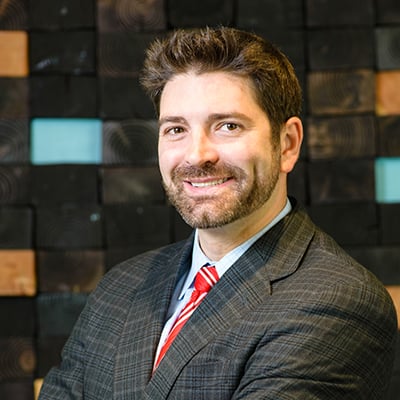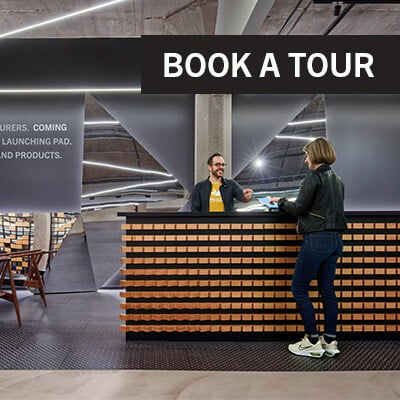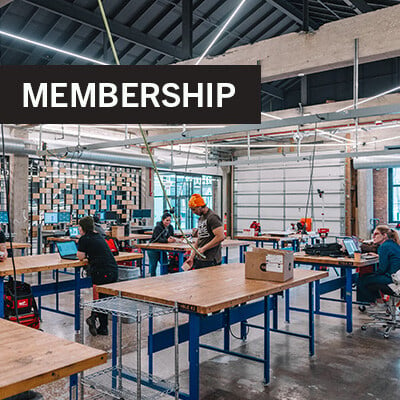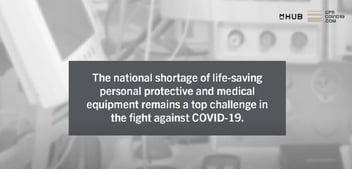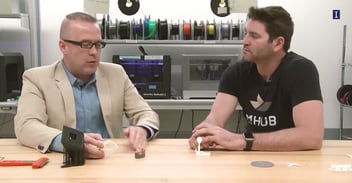CPR COVID-19: The Power of Collaborative Innovation
How Chicago's Hardtech Startups Repurposed Non-Traditional Components To Fill Critical Supply Chain Gaps During The Early Days of the Pandemic
By: Shannon McGhee and Keith Creighton
The core mindset of innovators and entrepreneurs is creative, agile and scrappy thinking that challenges the status quo to solve big problems. In this community, intentional disruption often is a business goal. But when a truly disruptive force like the COVID-19 pandemic altered the trajectories of most people’s lives and businesses, the Chicago innovation community quickly shifted priorities to benefit the greater good. The rolling shutdown had exposed weaknesses throughout the global economy, so local entrepreneurs teamed up to identify a variety of pressing needs within the medical supply chain that they would be uniquely qualified to tackle.
Previous pandemics of the modern age, including SARS, MERS and Ebola, were pretty much contained before widely affecting the US mainland. The unpredictable nature and rapid worldwide spread of COVID-19 caught most countries off guard. America’s healthcare infrastructure and manufacturing supply chain was not prepared on several fronts -- Personal Protective Equipment (PPE) for both first responders and medical professionals was in short supply; a crisis compounded by sudden consumer demand, as masks were identified as a way to slow the spread in public places. Ventilators were also in short supply, sending cities, states and medical facilities to bid against each other on the open market to snap up what scarce products were available.
Zooming out from the immediate shortages making headlines, the pandemic exposed a fault line running underneath the entire global economy. In the previous decades, companies offshored a large percentage of manufacturing as a way to drive down costs and drive up stock prices. China, the first country affected by COVID-19, had become the world’s primary manufacturer of PPE and testing equipment, including the components needed to develop basic technologies and products. Many Chinese factories temporarily shut down creating an immediate block in the global supply chain. Every hour that passed left more front line workers exposed to COVID-19, setting into motion a domino effect that was only going to get incrementally worse.
No one company, program or product could possibly bear the burden of saving the world -- but if everybody made an effort, the collective response could have a monumental impact. For the average citizen, this meant social distancing and wearing a mask when in public. For most businesses, this meant closing, shifting product and service delivery models, or transitioning offices to “work from home”. For the Chicago tech ecosystem, responding meant gathering engineers and entrepreneurs from the city’s leading innovation centers (mHUB, 1871, MATTER, and all of their related networks) and tasking them to think through unique, immediate and innovative solutions. The initiative, named Chicago Proactive Response (CPR) COVID-19, kicked into gear to mobilize the larger tech ecosystem to fight the pandemic.
Entrepreneurs, financiers and civic leaders had spent the last decade building a Midwestern tech ecosystem, with Chicago as the hub; today the City of Big Shoulders is now a global city for innovation. By harnessing the collective power of more than 1000 startups within the networks of mHUB, MATTER and 1871; Chicago had the right ingredients to make both a local and global impact.
mHUB leadership knew their community was uniquely qualified to address many of the initial crisis flash points seen in the news; they personally felt taking a proactive approach was the right thing to do. “Fighting this pandemic isn’t just the burden of healthcare workers, it is our duty as innovators to leverage our skills to make an impact,” said Bill Fienup, co-founder and director of innovation services at mHUB. “This is what mHUB and our product development group does. Large corporations come to us with a problem, and we build a team to solve it in a way that is faster and more cost-effective than the status quo.” COVID-19 was an exponentially bigger challenge to take on, which is why focus was key. If the mHUB community could set its sights on specific problems they were most capable of solving, they could make an immediate impact. “We put out the word to the mHUB community and everyone who was able to, signed on,” Fienup said.
As goals were set and projects came into focus, mHUB, 1871 and MATTER accessed industry leaders and entrepreneurs willing to volunteer, donate their time, share their expertise and come together in service of a common goal. Within the first few hours, the CPR COVID-19 team made a list of what they knew (expertise and skills), what they had (resources and materials), and who they could reach out to (diverse talent, industry partners, manufacturers, and healthcare stakeholders).
Outside thinking has long been known to drive real innovation. The healthcare industry, or any vertical for that matter, doesn’t just need industry veterans and historical knowledge to solve problems; entrepreneurs and engineers can apply their skills and resourcefulness to just about any task in front of them. By shifting focus from business objectives to humanitarian responses that quite literally impact every person across the world, the resulting work illustrates how fast innovation can happen when we break down silos and collaborate.
During the first phase of CPR COVID-19, mHUB focused efforts on helping medical professionals and first responders on the front lines -- their safety was critical to keep the entire healthcare system on the rails as it ramped up to take on a deluge of potential patients to test and treat. The mission then diverged into three paths forward: medical equipment, sterilization and sanitation, and personal protection. Speed was of the essence, to protect responders on the front lines as supply chain challenges ebbed and flowed.
mHUB, its partners, and member companies started working on 10 simultaneous projects while networking with colleagues around the region to ensure efforts were put towards the most pressing needs and fully leveraged thinking from diverse disciplines and expertise. They also used crowdsourcing directly from friends and family throughout their social and professional networks to generate funds to cover materials. Projects, once completed, would be sold at the most affordable price possible since budgets were stretched thin throughout the industry.
Of the many projects brought to market or still in development, three spotlight the range of thinking, collaboration and resourcefulness of the entire CPR COVID-19 project:
Automated Bag Compression Device (ABCD)
The sudden spread of COVID-19 created a need for new respirator models that could be manufactured in large quantities quickly. Many emergency respirator designs based off of manual resuscitators are costly, require a microprocessor and firmware and contain components that are difficult to source. Upon assessing the needs of hospitals in the area, the team developed a concept based on simple pneumatics and electronics that could be manufactured more quickly than many other designs. Components used within the device are broadly available and cost less than $200, which is far less than the average cost of other emergency respirators designed in the wake of the coronavirus pandemic. It features a housing which holds a disposable manual resuscitator in place, as an air cylinder moves a paddle that ultimately compresses an AMBU bag. Adjustments can be made to control the volume of air delivered to the patient's lungs, the number of breaths per minute, the speed of the breaths and the interval between breaths in and breaths out as a ratio. The device can attach to standard compressed air available in Hospitals and is run on electrical power and has a patent pending.
The development team includes Bill Fienup, director of innovation services, mHUB; Dr Mozziyar Etemadi, Patrick Hunt, Alex Heller of the Etemadi Research Group at Northwestern Medicine; Mike Rafferty, Owner of Rafferty Engineering; Nemera (Insight Product Development); Innoblative; Brightseed; and Henry Africano, Founder of HANK Industries.
Open Source Face Shield
mHUB’s 63,000 square-foot facility contains 10 fabrication labs, including electronics, plastic fabrication (3D printing), metals, textiles and rapid prototyping, as well as a microfactory for small production runs. The team brainstormed things mHUB could produce on-site and secured extra manufacturing capacity through partners to scale quickly. While the COVID-19 virus is microscopic, it travels via droplets that are expelled from one body through exhaling or coughing, infecting others though the mouth, nose or eyes. Face shields provide a level of protection that masks alone cannot. As PPE was in short supply, doctors and nurses were using just about anything they could get their hands on, including garbage bags, scuba masks, and plastic trays to duct tape together personal protection.
Responding to a request from Northwestern Memorial Hospital, mHUB spent a weekend working on face shield prototypes. The team had a working prototype within two hours; assembled pilots were in hospital by Monday. A week later, based on feedback from frontline hospital workers, mHUB began production using laser cutters, enlisting as many people as possible to safely craft, assemble and pack fully workable units. The first shipment of 100 was in the hands of frontline healthcare workers at Northwestern within a few days. That week, mHUB expanded production to 1,500/day onsite and secured the potential to scale up to 100,000 each week with local manufacturing partners. More than 14,000 shields have been supplied to local hospitals, including Advocate Silver Cross, Amita St Josephs, Advocate Christian, Advocate South Suburban, Cook County Health, and more. mHUB is continuing to work with regional health systems to assess broader demand.
The project team included Bill Fienup, director of innovation services, mHUB; David Mirkhaef, prototyping technician, mHUB; Mitch Muller, founder at SquareOne Product Development, a product design consultancy; and Mihai Hogea, co-founder of Pepper Life, Inc, maker of Pepper smart kitchen scale.
Powered Air-Purifying Respirator (PAPR) Device
Appropriate PPE includes many layers; it usually takes a long time for a medical professional to suit up and suit down. Frontline workers are suffering cuts/lacerations on their faces because they are forced to use the same PPE all day, which can chafe the skin with moisture. Users are not supposed to wear one mask for 12 hour shifts or to reuse masks on subsequent shifts, but shortages forced them into doing so.
PAPR is an essential device to help medical professionals safely treat patients diagnosed with COVID-19; it whisks away exhaled CO2, replacing it with fresh, filtered air. The mHUB team of more than 20 volunteers, led by member company Jiobit, was able to address manufacturing and supply chain challenges to create a PAPR prototype that is affordable, dependable, and uses readily available components. Core components include a vacuum cleaner HEPA filter, scuba mask, the bilge hose from a sump pump, the blower motor used to cool a computer, and the battery used as a computer’s external power supply. Compiling parts, used to link these disparate components together, were fashioned in use using available 3D printers and machining equipment. The device is easy to sanitize and adjust; plus it can be sold for a mere $275.
To date, 25 units have been distributed to the State of Illinois and another 25 units were donated to VA hospitals, emergency first responders, and ICU nurses across the US.
The project team includes Roger Ady, CTO and co-founder of Jiobit, makers of a wearable location monitor designed by parents; Mitul Patel CEO at MP Consulting, a consulting company offering end-to-end solutions for product design; and Nick Cucci, Brian Michalak, David Carhart, and Steve Gaynes from PDT, an Astronics company.
Moving Forward
As the Summer of 2020 plays out, the COVID-19 crisis is still rapidly unfolding worldwide. Constantly refreshed learning throughout the scientific community is quickly replacing or updating theories, strategies and plans that were in place just days and weeks ago. While many pre-pandemic projects throughout the Chicago tech community are steadily getting back on track, the CPR COVID-19 initiative remains just as active. New teams are forming to take on new challenges while others are constantly perfecting projects already in development.
This crisis has shown what can happen when people unite to reach a common goal, driving truly collaborative innovation. We saw this on a human level, in neighborhoods from coast to coast, as people who can help others, did. In the tech sector, we saw silos come down and great ideas rise up. Nobody on the front lines or in supporting roles could have possibly imagined a year ago that this is where they’d be today, and yet, here we are -- solving problems and taking action -- on a path to emerge stronger, more connected, and more productive than ever before. Even once the threat of COVID-19 passes, new crises, challenges and opportunities will emerge, and time and again, collaboration will be at the forefront of finding solutions.
